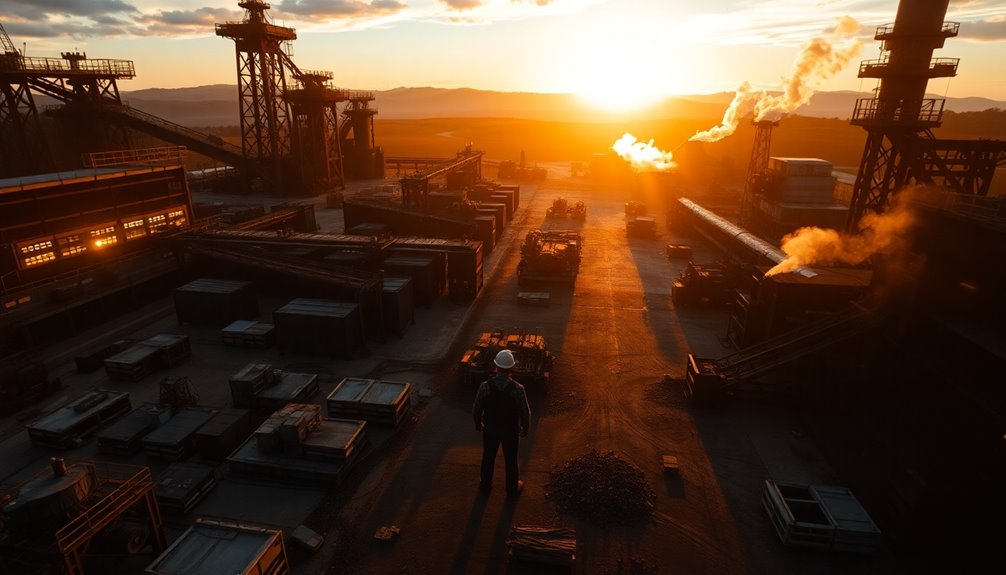Foundry's recent job cuts and strategic shifts reveal its commitment to steering through the challenging Bitcoin mining sector. By reducing its workforce by 27% and streamlining operations, you're seeing Foundry prioritize efficiency and long-term stability. Amid financial pressures and an impending Bitcoin halving, the company aims to enhance profitability while maintaining key services. Foundry continues to hold a significant share of the network's hashrate and is exploring diversification into AI and renewable energy, reflecting a proactive approach to sustainability. Curious about the future challenges it faces and what lies ahead? Keep exploring to discover more insights.
Key Takeaways
- Foundry reduced its workforce by 27% to enhance efficiency and profitability amid financial pressures in the Bitcoin mining industry.
- The company anticipates generating $80 million in revenue from self-mining in 2024, focusing on core operations.
- Foundry holds a 30% share of the Bitcoin network's hashrate, positioning itself competitively against major players like Antpool.
- Transitioning to renewable energy is crucial for improving profit margins and attracting institutional investors aligned with sustainability mandates.
- Restructuring efforts are part of Foundry's strategy to stabilize operations and recover from financial challenges following DCG's debt issues.
Overview of Job Cuts

In recent weeks, Foundry has made significant cuts to its workforce, laying off nearly a third of its employees. The layoffs reduced the headcount from 274 to 200, impacting various teams across multiple business lines. More than half of those affected were based in the U.S., with approximately 16% of the total workforce being U.S. employees.
The cuts were extensive, reaching departments like self-mining, custom hardware, ASIC repairs, site operations, firmware, and decentralized AI infrastructure. While the hardware line is being deprioritized, it hasn't been entirely shut down, and the ASIC repair business line remains intact.
Employees received individual notifications before a company-wide meeting, signaling the gravity of the situation. Remarkably, a significant number of employees moved to a new subsidiary, Yuma, as part of the restructuring. This strategic shift is driven by the decision to spin off its AI division into the new subsidiary, Yuma.
Despite initial reports suggesting that up to 60% of employees would be laid off, Foundry clarified that the actual figure was 27%. This adjustment reflects the company's focus on its core business of bitcoin mining, which remains its most significant venture, accounting for 30% of the Bitcoin network's total hashrate.
Reasons for Workforce Reduction

You'll notice that Foundry's workforce reduction stems from a clear focus on core business operations and the need for restructuring to boost efficiency. As financial pressures mount, the company is prioritizing stability to navigate challenges in the Bitcoin mining landscape. This shift not only aims to streamline operations but also to guarantee long-term profitability. With the expected revenue from self-mining projected at $80 million by 2024, Foundry is strategically positioning itself for future growth.
Core Business Focus
Why did Foundry decide to reduce its workforce by 27%? The company aimed to sharpen its focus on core business lines, which include operating the leading Bitcoin mining pool and expanding site operations.
By laying off 74 employees, 16% of whom were based in the U.S., Foundry is positioning itself to strengthen its market presence. This strategic realignment also involves deprioritizing custom hardware initiatives, allowing the company to concentrate on more profitable areas.
Foundry's Bitcoin mining pool is a significant player, accounting for 30% of the Bitcoin network's total hash rate, while its self-mining business is projected to generate $80 million in revenue for 2024. Additionally, the company is adapting to increasing pressure to utilize renewable energy sources, ensuring compliance with environmental regulations.
To support this focus, 20 employees were reassigned to Yuma, a decentralized AI startup, reflecting Foundry's commitment to operational efficiency and innovation.
These changes not only streamline operations but also align with Foundry's strategy to maintain profitability within the evolving landscape of Bitcoin mining.
As the company prioritizes its core revenue-generating activities, it remains grateful for the contributions of all employees impacted by the layoffs.
Restructuring for Efficiency
As Foundry navigates the challenges of the Bitcoin mining landscape, it's made the tough decision to reduce its workforce by 27% to enhance operational efficiency. This means laying off 74 employees, shrinking the team from 274 to 200.
While 16% of the layoffs impacted US employees, the company also transferred 20 workers to Yuma, a decentralized AI startup, aligning with the development of DCG's latest subsidiaries.
The restructuring deprioritizes custom hardware initiatives, focusing instead on core operations. Though Foundry maintained its ASIC repair services initially, it later let go of the entire ASIC repair and hardware teams. Additionally, the self-mining business is projected to generate $80 million in revenue for 2024, highlighting the importance of core operational focus.
Key divisions—like the Bitcoin mining pool, firmware team, and self-mining division—remain intact, allowing the company to sharpen its focus.
This strategic realignment comes amid broader challenges for DCG, including the bankruptcy of its lending subsidiary, Genesis.
Foundry's changes reflect an urgent need for efficiency and cost-cutting in a volatile market. As the company accounts for 30% of the Bitcoin network's total hash rate, these layoffs represent a critical step in adapting to industry pressures and securing a stronger market position.
Financial Stability Goals
Foundry's recent workforce reduction reflects its urgent need to address financial stability goals amid escalating pressures in the Bitcoin mining sector.
With the upcoming Bitcoin halving in April 2024 slashing mining rewards in half, smaller miners face a grim future, struggling to maintain profitability. Rising energy costs further squeeze profit margins, pushing miners to find cheaper, often renewable, energy sources to stay competitive. The mining process, which relies on a proof-of-work system, continues to demand substantial energy, necessitating a shift towards more sustainable practices.
To survive, you'll need to focus on cost-efficient operations, which means prioritizing regions with surplus renewable capacity, like Texas. Here, using renewable energy not only reduces operational costs but also helps stabilize the energy grid.
As less efficient operations close or consolidate, only those with efficient mining fleets and low energy costs will thrive.
Additionally, diversifying into AI and cloud computing can help absorb fixed overhead costs and provide additional revenue streams. Companies like Bit Digital are already making strides in this direction, recognizing the need to diversify to withstand hash price volatility.
Stricter regulations on carbon emissions also push miners toward greener practices. By adopting renewable energy and complying with ESG criteria, you can attract more investors while ensuring your operations align with sustainability goals.
Impact on Business Operations

The recent layoffs at Foundry considerably impact its business operations, reshaping teams and resources. By cutting 27% of its workforce, Foundry reduces its headcount from 274 to 200 employees, affecting various teams, including ASIC repair and hardware.
While about 16% of those laid off are U.S. employees, some staff members moved to Yuma, a new subsidiary focusing on decentralized AI technology.
Despite these cuts, Foundry maintains its core operations, such as the mining pool, firmware team, and self-mining division, which remain partially intact. Custom hardware initiatives are deprioritized, but ASIC repair services continue to operate.
The site operations business line remains a key focus, demonstrating Foundry's commitment to its essential functions. Additionally, as the largest Bitcoin mining pool globally, Foundry aims to leverage its position to enhance profitability and stability amidst industry challenges.
These changes align with broader restructuring efforts following financial difficulties faced by Digital Currency Group (DCG). As Foundry aims to strengthen its market position, it anticipates that its self-mining business will generate around $80 million in revenue for 2024.
Foundry's Bitcoin Mining Pool

Foundry's Bitcoin Mining Pool
Dominating the Bitcoin mining landscape, Foundry's Bitcoin Mining Pool holds a significant market share, accounting for approximately 30% of the network's total hashrate. This impressive presence has allowed Foundry to mine 41 blocks in just 24 hours, matching its competitor, Antpool, and collectively controlling nearly 60% of the blocks produced.
- Has a hashrate of 181 EH/s, one of the industry's highest.
- Supports major publicly traded Bitcoin miners like Cipher Mining and Bitfarms.
- Provides a suite of services, including treasury management and BTC collateralized lending.
- Guarantees transparency and compliance with full disclosure of earnings.
- Designed for institutional miners, focusing on security and reliability.
Despite recent layoffs, Foundry's Bitcoin Mining Pool remains an essential part of its operations, contributing to the overall decentralization of Bitcoin's hashrate. Concerns over mining centralization have been raised as both Foundry and Antpool dominate the market.
With a focus on stability through features like FPPS payout mode and robust security measures, you can see how Foundry continues to attract institutional clients. Their relentless push for growth and dominance indicates they're not just surviving but thriving in a challenging environment.
Spin-Off of AI Arm

Intel's decision to spin off its AI arm into an independent subsidiary marks a crucial shift in its strategy. This move aims to enhance efficiency and profitability, establishing a clearer separation for external customers and suppliers.
The new subsidiary will have its own board of directors, which will govern operations and challenge performance, ensuring a focused approach to business.
Financially, this spin-off comes after Intel Foundry has become a significant financial drain, costing about $50 billion over the past two years. By creating this independent entity, Intel opens doors for evaluating alternative funding sources and optimizing its capital structure. Additionally, the subsidiary will aim to raise outside funding, a vital step towards achieving financial stability.
Operationally, while construction on factories in Germany and Poland has paused, Intel continues building in Arizona, Ohio, Oregon, and New Mexico.
This shift also allows Intel to ramp up its production of chips using the new 18A chipmaking process, increasing competition in the AI chip market and enhancing partnerships, particularly with Amazon Web Services for custom AI chip designs.
Challenges in Bitcoin Mining

You can't ignore the challenges that come with Bitcoin mining, especially when it comes to energy consumption. Rising regulatory pressures and market volatility only add to the complexity, making it tough to navigate this landscape. As you explore these issues, you'll see how interconnected they're and their potential impact on the future of mining. Additionally, the carbon emissions from bitcoin mining are estimated at 65 Mt CO2 annually, equivalent to Greece's emissions, highlighting the urgent need for sustainable practices within the industry.
Energy Consumption Issues
There's no denying that energy consumption is a considerable challenge for Bitcoin mining. As you examine the world of cryptocurrency, you'll quickly realize the staggering amounts of electricity involved.
Here are some key points to reflect on:
- Bitcoin mining consumes roughly 0.5% of all global energy.
- It uses more electricity annually than the entire country of Argentina.
- One Bitcoin transaction can use up to 1,200 kWh, equivalent to nearly 100,000 VISA transactions.
- About 22-23 million metric tons of carbon dioxide are generated each year from mining activities.
- The environmental footprint varies greatly based on the energy sources used.
These figures paint a concerning picture. Bitcoin's energy consumption often rivals entire nations, raising questions about sustainability. In fact, Bitcoin's annual consumption is roughly 160 terawatt-hours, which surpasses the total energy output of Argentina.
Approximately 65 megatons of CO2 emissions arise from mining operations, comparable to Greece's annual emissions. The reliance on fossil fuels, especially in certain regions, exacerbates the climate impact.
As you explore this space, keep in mind the balance between innovation and responsibility. The future of Bitcoin mining hinges on addressing these energy consumption issues while finding greener alternatives.
Regulatory Pressures Rising
As Bitcoin mining grapples with significant energy consumption challenges, regulatory pressures are mounting across the globe. At least eight countries have imposed outright bans on cryptocurrency mining, primarily targeting Bitcoin's energy-intensive Proof of Work mechanism.
Kazakhstan, once a mining hotspot, has enacted higher taxes and restrictions, limiting miners to operating only when the grid has surplus electricity and requiring licenses.
In Canada, provinces like New Brunswick and British Columbia have paused new Bitcoin mines due to electricity supply issues and threats to clean energy goals. New Brunswick has even proposed a permanent ban on new mining operations.
Local governments are also stepping in, using zoning and noise ordinances to restrict mining activities, while Texas has mandated registration for large-consuming miners.
Environmental concerns further amplify these regulatory pressures. High carbon emissions and electronic waste from Bitcoin mining have caught the attention of regulators looking to enforce stricter guidelines. Additionally, several countries are experiencing energy shortages due to mining, prompting regulatory actions to safeguard their electrical grids.
These regulations vary by region, with some jurisdictions offering incentives for using cleaner energy sources. As these challenges grow, miners must adapt quickly or risk facing significant operational hurdles.
Market Volatility Concerns
Market volatility poses a significant threat to Bitcoin miners' profitability, making it vital to navigate the unpredictable landscape of cryptocurrency prices. With Bitcoin's value frequently fluctuating, you might find your operational costs outpacing potential gains.
- Current Bitcoin prices hover around $52,500, limiting profitability for most mining rigs.
- A drop to $52,000 could push many miners into unsustainable losses.
- Mining 1 BTC costs approximately $53,000, making any drop below this threshold detrimental.
- High energy costs coupled with price volatility create a challenging environment for miners.
- Efficient equipment is essential to maintain profitability amid these fluctuations.
As mining difficulty reaches unprecedented levels, obtaining rewards becomes increasingly challenging. This situation is compounded by rising operational costs, prompting you to reflect on upgrades to more efficient mining rigs. The continuous need for efficient models is becoming more critical as profitability narrows.
Without innovative solutions and efficient setups, your margins could dwindle rapidly. The landscape is shifting, and only those who adapt to the market's unpredictable nature will survive. Staying informed and proactive is essential to weathering the storm of market volatility in Bitcoin mining.
Regulatory Considerations

Maneuvering the complex landscape of regulatory considerations is vital for those involved in Bitcoin mining. As you navigate these waters, you'll encounter a variety of regulations that can either support or hinder your operations. For instance, several countries have imposed outright bans on mining, while others have implemented taxes and surcharges that can greatly affect profitability. Crypto mining operations consume up to 2.3% of U.S. electricity, highlighting the significant energy demands that regulators must consider when drafting legislation.
Here's a quick overview of some key regulatory aspects:
| Regulatory Aspect | Details |
|---|---|
| Global Bans | At least 8 countries have outright bans on mining. |
| Taxes and Surcharges | Countries like Kazakhstan impose taxes based on electricity prices. |
| Moratoriums | Provinces in Canada have moratoriums on new mines. |
| Right-to-Mine Laws | States like Montana protect miners from local regulations. |
| Regulatory Oversight | Multiple agencies oversee crypto, creating a complex environment. |
Understanding these regulations is essential as they can impact everything from operational costs to market stability. By staying informed, you can better position your mining operations for success in this ever-evolving landscape.
Transition to Renewable Energy

The shift to renewable energy in Bitcoin mining isn't just a trend; it's becoming a strategic imperative for miners looking to enhance profitability and sustainability.
By embracing renewables, you can tap into a variety of benefits that not only improve your bottom line but also align with broader environmental goals.
- Renewable energy is often cheaper than fossil fuels, boosting your profit margins. Regular maintenance of energy systems can further enhance efficiency and cost-effectiveness.
- Attract institutional investors by operating under ESG mandates, lowering your capital costs.
- The significant drop in solar and wind energy costs makes them attractive options for mining operations.
- Flexibly adjust your energy use based on grid demand, stabilizing the energy supply.
- Reduce your carbon footprint, addressing sustainability concerns and enhancing public perception. Bitcoin mining can support the transition to cleaner energy by partnering with renewables. Additionally, incorporating wood-burning stoves can further enhance energy efficiency in mining operations through effective heating solutions. Commercial grade heat pumps can also play a pivotal role in optimizing energy usage for mining operations. Geothermal heat pumps can achieve efficiency ratings of 300% to 600%, further reducing operational costs. Hydrogen can be produced from renewable energy sources and offers a sustainable alternative to fossil fuels.
Transitioning to renewable energy sources isn't just about cost savings; it enhances grid reliability by participating in demand-response programs.
This flexibility allows you to support the grid during peak demand, while also providing opportunities for local job creation and infrastructure development.
DCG's Restructuring Efforts

DCG's restructuring efforts are vital for regaining financial stability after the Genesis bankruptcy. You'll see a strong emphasis on core ventures as they streamline operations and focus on profitable business lines. The impact of the bankruptcy looms large, shaping their strategies to recover and rebuild. As part of this realignment, Foundry recently laid off 27% of employees to concentrate resources on its most successful operations.
Financial Stability Strategies
Amidst the turmoil following Genesis's bankruptcy, Digital Currency Group (DCG) is taking decisive steps to stabilize its financial footing. The recent liquidity crisis has pushed DCG to implement a thorough restructuring plan aimed at addressing their financial challenges.
Here are some key strategies DCG is employing:
- Consolidating Genesis-related entities under Genesis Global Holdco.
- Settling a legal dispute by paying $324.5 million in cash and $158 million in cryptocurrencies.
- Refinancing $526 million in existing term loans to benefit creditors.
- Selling Genesis Global Trading as part of the creditor agreement.
- Disposing of CoinDesk for approximately $75 million to bolster cash flow.
These actions are vital for DCG to recover from the Genesis fallout. The restructuring plan, pending court approval, aims to guarantee that Genesis's creditors can expect to recover at least 80% of their funds. Additionally, the restructuring is designed to create a path for creditors to potentially recover up to $1.00 per dollar deposited.
Focus on Core Ventures
Foundry is sharpening its focus on core business lines as part of DCG's restructuring efforts. The company is zeroing in on its position as the operator of the world's #1 Bitcoin mining pool, which currently accounts for 30% of the Bitcoin network's total hashrate.
Additionally, Foundry is emphasizing the growth of its site operations business while keeping key divisions like mining pool operations, the firmware team, and self-mining intact. The self-mining segment is projected to generate around $80 million in revenue for 2024, and this aligns with Foundry's goal to maintain its largest mining pool status.
To streamline operations, Foundry has deprioritized non-core ventures, which includes shutting down custom hardware initiatives and dismissing the ASIC repair and hardware teams.
While decentralized AI infrastructure remains functional, staff transfers to Yuma signify a shift in focus. The company has also eliminated its prior practice of extending 0% fees to its largest clients and moved away from ASIC-backed loans, which were briefly offered in the past.
With approximately 60% of its workforce laid off, Foundry is working to realign itself strategically, ensuring that its efforts center on its most profitable operations.
Impact of Genesis Bankruptcy
In light of the Genesis bankruptcy, the restructuring efforts at Digital Currency Group (DCG) have become critical for stabilizing the company's finances. The fallout from this situation has been significant, with DCG absorbing a staggering $1.1 billion in debt from Genesis.
As they navigate this crisis, several key factors stand out:
- Genesis owed over $3.5 billion to its top 50 creditors at bankruptcy.
- The court approved a $3 billion distribution, covering about 77% of creditor claims.
- Creditors with USD claims will recover fully, while those with crypto face a shortfall.
- DCG contributed equity in Genesis Global Trading to aid restructuring efforts.
- Legal challenges from the SEC and other parties complicate recovery.
These moves, including refinancing $526 million in term loans and selling off assets like CoinDesk, show DCG's commitment to regain stability. Additionally, the court ruling that deemed insufficient value in estates for DCG recovery underscores the challenges they face.
However, they also highlight the precarious nature of their financial standing, with a court ruling indicating no recovery for DCG as an equity holder.
This restructuring phase will be pivotal for both DCG and Genesis as they work to emerge from this tumultuous period.
Future Outlook for Foundry

How will the future unfold for Foundry as it navigates a rapidly changing landscape? With a significant workforce reduction of up to 60%, Foundry is focusing on its core operations like the Bitcoin mining pool and site management. This shift aims to streamline operations and allocate resources more effectively in an increasingly competitive industry. Bitcoin giant Foundry’s bold reset demonstrates a commitment to sustainability and adaptability, even amidst challenging market conditions. By doubling down on its core strengths, Foundry is positioning itself to emerge leaner and more resilient in the evolving crypto ecosystem.
While layoffs affected the ASIC repair and hardware teams, the mining pool remains a key area of strength. This strategic shift is essential for stabilizing finances, especially as they project $80 million in sales from self-mining by 2024. As part of its restructuring, the self-mining division is set to become an autonomous entity under Digital Currency Group, which will further enhance operational focus.
To bolster competitiveness, Foundry USA maintains a strong market presence, holding about one-third of the global Bitcoin mining pool share. As the industry evolves towards renewable energy, Foundry's commitment to sustainability and innovation will be critical.
They're investing in efficient mining equipment and adapting to regulatory changes to stay ahead. However, challenges remain, particularly in securing financial stability amid defaults on ASIC-backed loans.
Foundry must diversify funding sources and develop robust operational models to thrive in both bullish and bearish cycles. By leveraging its market position and focusing on sustainability, Foundry can carve out a promising future in the cryptocurrency landscape while addressing environmental concerns.
Frequently Asked Questions
How Will Layoffs Affect Foundry's Company Culture?
Layoffs can greatly impact Foundry's company culture. You might notice a shift in morale, as trust could diminish among remaining employees.
Increased workloads may lead to stress and burnout, affecting collaboration. As responsibilities change, clarity in communication becomes essential to avoid confusion.
However, if management focuses on transparency and support, it could foster resilience and a more specialized environment.
Ultimately, how you navigate these changes will shape the future culture at Foundry.
What Support Will Laid-Off Employees Receive?
You won't find any specific support or resources mentioned for laid-off employees.
There's no information about severance packages, financial assistance, or career counseling. Employees were notified individually, but the focus seems to be on strategic realignment rather than helping those affected.
If you're among those laid off, it's crucial to seek external support networks or resources to navigate this change, as the company isn't providing any structured assistance in this challenging time.
Will There Be Future Hiring at Foundry?
Imagine a ship steering through a storm, shedding weight to stay afloat.
As Foundry trims its sails, future hiring seems uncertain. While the focus is on its core operations, you might see opportunities arise as the self-mining division grows.
If the winds shift and investments flow in, new talent could be welcomed aboard.
For now, though, it's a matter of watching for signs of calmer seas ahead before any hiring begins.
How Does Foundry Plan to Retain Top Talent?
To retain top talent, Foundry focuses on core operations and strategic transfers, ensuring key divisions remain strong.
They support employee development through potential workshops, stipends for education, and attendance at industry conferences.
By offering flexible work arrangements and performance bonuses tied to achievements, they create an attractive work environment.
Additionally, health and wellness programs can enhance employees' well-being, making it easier for you to stay engaged and committed to the company's success.
What Is the Timeline for Yuma's Development?
Yuma's development timeline is ambitious yet focused. Officially launched in November 2024, it quickly began integrating into the Bittensor network.
You'll see Yuma actively participating as a validator and miner, while also rolling out accelerator and incubation programs. They're not just building; they're reshaping the future of decentralized intelligence.
As they grow, expect strategic partnerships and innovative subnets to emerge, pushing boundaries in AI and crypto integration. Exciting times lie ahead!
Conclusion
In steering through these turbulent waters, Foundry's bold moves are like a ship adjusting its sails in a storm, aiming to find calmer seas. While job cuts may sting in the short term, they're part of a strategic plan to embrace the future of Bitcoin mining. By investing in AI and renewable energy, Foundry is positioning itself to thrive in an evolving landscape. Keep an eye on their journey; it could reshape the industry in ways we can't yet imagine.










